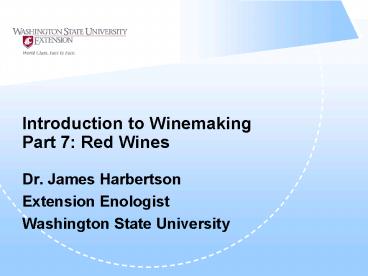Introduction to Winemaking Part 7: Red Wines - PowerPoint PPT Presentation
1 / 15
Title: Introduction to Winemaking Part 7: Red Wines
1
Introduction to Winemaking Part 7 Red Wines
- Dr. James Harbertson
- Extension Enologist
- Washington State University
2
Red Winemaking Techniques
- Warm Fermentation
- Skin and seed contact time
- Mixing Techniques
- Extended Maceration
- Press fractions
- Enzyme Additions
- Tank fermentations
- Barrel aging
- Dry w/ML
- Blending
3
Warm Fermentations
- Most reds ferment at warm temperatures (70-90?C)
- Oxidation is generally not an issue because
surface layer of CO2 - Skins and seeds are less dense than fermenting
liquid forming a cap (about 1/3 volume) - Cap requires mixing to prevent drying
- Mixing techniques vary and influence the color
and astringency of the wine
4
Skin and Seed Contact
- Duration of contact time is controlling factor
for extraction of color and tannin extraction. - Tannin impart astringent character to wine and
act as a color stabilizer - EtOH also helps to extract color and tannin
- Technique known as extended maceration will
increase the tannin of a wine but not the color - Higher tannin is desirable in wines that are
meant to be aged (unpleasantly too tannic young)
5
Cap Example
6
Mixing Techniques
- Punch Down
- Device used to break up cap and submerge it into
fermenting liquid - Pump Over
- Volume of liquid is taken from racking valve and
pumped back onto cap to wet it - Rack and Return
- Entire volume of liquid is racked off and then
poured back onto cap to fully submerse it - Often seeds are removed from bottom of tank
during this process to avoid extraction of bitter
compounds
7
Punch Down Example
8
Pressing
- A press is used to extract juice from the skins
and pulp of grape - Determining when to press depends on wine type
- Different types of presses are used to achieve
different outcomes - Bladder presses are the most commonly used
- Screw and basket presses are old effective means
- Continuous presses are more rare
- Both screw and continuous presses are avoided
because they often damage seeds and skins and
extract unwanted components
9
Press Fractions
- Bladder Press uses air pressure to release juice
- Amount of pressure and rotation speed is
controlled - Gently process that does not damage seeds or
skins - Increases juice yield
- Free run is high quality
- Press fractions kept separate for topping
10
Barrel Aging
- Reds are stored in barrel and undergo ML
- Stored for 6-8 months generally
- Barrel components are extracted into wine
depending on Barrel type and age of barrel - Young barrels contain more extract
- Toast type and wood origin change extraction and
price (French 300-600 US 150-300) - After 3 years barrels are usually sold
11
French Examples
- Burgundy and Beaujolais
- Pinot noir and Carbonic Maceration
- Bordeaux
- Cabernet Sauvignon, Merlot, Cabernet Franc,
Malbec, Petite Verdot - Rhone
- Syrah, Grenache, Mouvedre, Viognier
12
Burgundy
- 100 Pinot noir Cool Region
- Typically strawberry and earthy characters
- Low, acid, color and astringency
- Chaptalization (can have high EtOH)
- Made in small tanks aged in barrel
- Challenging variety because it is difficult to
extract a lot from lightly colored berries
13
Beaujolais
- Southern Burgundy (Gamay noir variety used)
- Described as a lightly colored low astringency
distinctive wine - Beaujolais Nouveau
- Harvested and quickly made into wine
- Released on the third Thursday in November
- Carbonic maceration technique
- Grapes blanketed in CO2 and begin to partially
ferment themselves (up to a weekML begins
usually during this time) - Skin breaks down during this process and
coloration is achieved - Skins removed and juice is fermented normally
- End product has distinctive aroma (aldehydic)
14
Bordeaux
- Blended wines with dark color and high
astringency - Heavy extractive techniques are used in making
these wines (extended maceration, mixing
techniques) - Cabernet Sauvignon, Merlot, Cabernet Franc are
major - Petite Verdot and Malbec are minor
- Some regions of Bordeaux are all Cabernet
Sauvignon or Merlot - Aged in barrel and consumed after a long period
of aging - Bottles have pronounced shoulders to easily
collect sediment
15
Rhone
- High color and medium to high astringency wines
- Mixing techniques primarily, oak aged
- Northern Rhone is cool Southern Rhone is warm
- Blended wines
- Syrah, Grenache, Carignan, Viognier
- Northern Rhone makes Syrah based wines
- Southern Rhone makes Grenache based wines
- Village in N. Rhone called Cote Rotie makes
Syrah, Viognier blend































